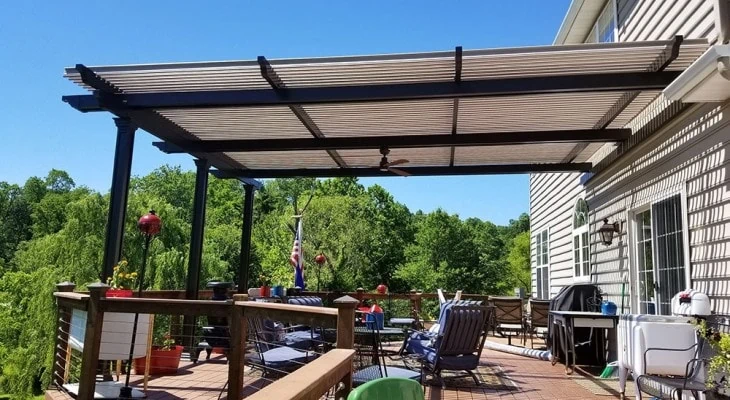I had been living in Florida for seven years and had just bought my first home. Imagine my surprise when my son and I had to evacuate just three months after closing on the house because of a hurricane!
When I returned, my neighbor’s deck canopy was in my front yard, and it made me wonder, is it possible to provide shade for your deck if you live in a really windy area?
Though it seems unlikely with hurricane-force winds, it is possible to have deck shades that can withstand the force of strong winds. I have seen pergolas around some of the more expensive homes, shade sails, which I would think would be a problem but are not, and many homes with a cantilever umbrella on their pool deck.
Table of Contents
Factors to Consider When Installing a Deck Shade in a Windy Area

The first thing you want to consider is how windy your area can be. Where I live, hurricanes and tornadoes are the norm, so I would expect maximum wind gusts over 60 mph and need to build with that in mind.
To calculate the wind speed, you can purchase a gauge called an anemometer. This instrument can measure how fast the winds are traveling in your area at any given time. If you live in hurricane territory as I do, make sure you purchase one for higher wind speeds, such as this one, which measures gales up to 100 mph.
You also need to decide how much shade you are looking for. This is to ensure that you’re purchasing something large enough to cover your area.
If you want to shade your entire deck, you may look for a wind-resistant shade sail or consider a pergola. If you want just a small to medium portion of your deck shaded, they do make some umbrellas that can withstand wind speeds up to about 40 mph.
What to Consider When Using an Umbrella For Shade
- Purchase models made of vinyl or canvas. They can withstand strong winds and resist tearing.
- Purchase models made with aluminum frames and bases for durability.
- Choose a cantilever umbrella supported by a support rod on the side of the umbrella and not in the middle. You can also raise, lower, or tilt it to allow up to a full 360-degree rotation covering your pool deck.
- Anchor your umbrella down with a heavy metal base or a base you can fill with sand, water, or gravel.
A Pergola

A pergola is a structure with strong vertical posts supported by crossbeams. The roof is generally made of canvas, lattice, slats, metal, wood, or fiberglass. For very windy areas, it is best to use something that has slats so that the air will pass through.
Things to Consider When Building a Pergola Structure
- Build it with strong material such as a metal frame or hardwood using cross beams and support joists. This will help reinforce the structure and give it strength.
- Install it on a solid concrete foundation with metal bolts.
- For hurricane-force winds such as what I experience in Florida, consider hiring a professional to construct it correctly for you. Some manufacturers make hurricane-resistant pergolas.
- Consider lattice on the roof and sides so the wind can easily pass through. If the top and sides are solid, there is more risk of damage in high winds.
- Try to calculate, if possible, the specific wind direction for your yard, and then place your pergola at a 45-degree angle pointing in the direction of the oncoming wind. This can make it more aerodynamically sound and reduce the wind drag.
- If possible, place it as close to or even attached to your home. Doing this will increase its stability because there will be less direct wind flow.
Shade Sails That Resist High-Speed Winds

As long as shade sails are installed correctly, they are able to sustain high winds. They are designed to form a tension structure, so when the force of the wind hits the sail, the fabric tightens. As this happens, the tension is transmitted to the mountings, and as long as it is securely attached to the surface, it should be fine.
You can also have shade sails custom-made to withstand a high-wind area. So if you live in a location known for strong wind gusts or extreme weather, this would be your best option.
However, some problems can occur, such as when using your roof as your deck. When I first moved to Florida, my apartment was on top of the roof, and the roof was my yard. Rooftop decks are very common when you live near the ocean as the view is amazing! However, it can get really hot with all of that direct sunlight.
At the ocean, the wind speed is higher than it is inland. Conversely, with all the high-rise condominiums lined up right next to each other, the wind is forced to go in between the buildings, increasing the wind speed. When high winds come, it can cause the sail to vibrate, which travels down the structure and causes the roof to shake.
Because I didn’t have a deck shade, I never experienced this. However, I’ve heard that it can make the top floor of your home feel like an earthquake!
In Conclusion
It is possible to shade your deck if you live in a windy location. Just be sure to use solid materials built to sustain strong winds and that the frame is securely weighted down or anchored to the foundation.

